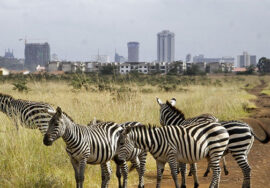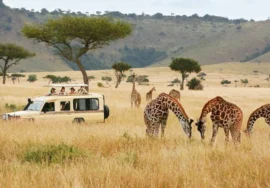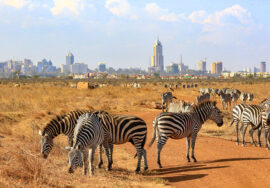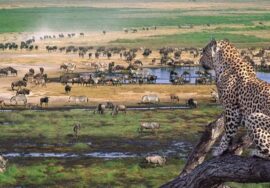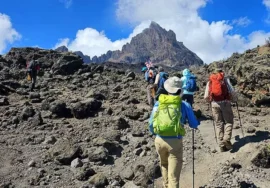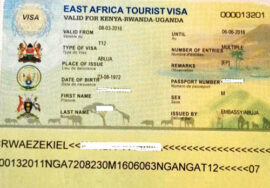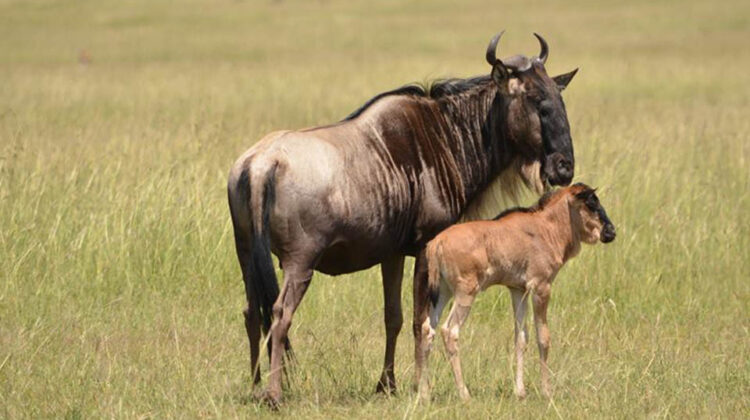
WILDEBEEST CALVING SAFARI
WILDEBEEST CALVING SAFARI, The amount of wildlife in front of you is too great to count. Thousands of wildebeests giving birth in huge groups that are hard to understand. The scene is moving, and it shows the start of almost endless new life… and then things got even more intense when dangerous animals like lions and cheetahs showed up to watch the babies.
Two million wildebeests come from the Masai Mara to the southern plains of the Serengeti every year between January and March. They are drawn to the fresh green fields that have been restored by recent rains. This food will be very helpful for them because it’s birth season and hundreds of thousands of wildebeests will be born.
There will be as many as 8,000 calves born every day in the Serengeti over the next few months, bringing the total number of babies born there to almost 500,000. Other grazers, like thousands of zebras, Thompson’s gazelles, and elands, also give birth at this special time. They instinctively use the safety of the wildebeests’ numbers to help protect their own young.
The wildebeest babies get used to their new surroundings quickly. They are able to stand up in minutes and run with the rest of the group in just a few days. They will need these skills to help them avoid the many animals that are interested in these new areas.
Find Out About Grazers and Predators
In a strange way, nature has a lot of similarities. For example, the Serengeti’s predators have always come to give birth at this time of year, when there is a lot of meat for their hungry young.
Even though there are a lot of newborn wildebeest babies in the fields, the cheetahs, hyenas, jackals, and African wild dogs that are often seen nearby can still make it hard to kill.
The mothers wildebeest come back to these fields every year, so they know them well. They have their babies in the lower grasses, which makes it easier for predators to see them. And whenever a cheetah or hyena comes close, groups of mothers form a wall around the babies to protect them and help them stay alive.
The time of year when a lot of calves are born is another way that nature helps to make sure that most of the young wildebeests will live. Once the predators have eaten all of their fresh meat, they are full and leave most of the weak calves alone.
Look at how nature takes care of its own.
Apart from the fact that predators and grazers depend on each other, the grazers also have a surprising support system. Many zebras and gazelles eat the longer grasses in these birthing fields, making them hard for the young wildebeest babies to eat. The shorter shoots are ready for the babies to eat now that the longer plants have been cut away.
Even the earth’s geological forces have had an effect on the birthing processes of these millions of animals. A long time ago, the area around Ngorongoro was a place where volcanoes were still active. Ashes fell on these areas, improving the soil and making grasses that are high in calcium and magnesium. Wildebeest moms who are pregnant are drawn to these grasses because they need them to feed their unborn calves.
So, the ground and soil from thousands of years ago play a big role in this huge show of life and death that you are seeing.
So why go on a safari to the calving fields?
It’s a big deal when hundreds of thousands of wild animals have babies, as you can see. You won’t see such an amazing sight anywhere else.
These fields are home to thousands of baby zebra, gazelle, and eland, as well as an endless number of wildebeest calves. And the plains’ lush vegetation marks the birthing season for many other animals. Baboons, warthog piglets, elephants, and giraffes are just a few of the animals that make the plains feel like a nursery.
During this time, the big cats are also giving birth to their young. You can see lion, leopard, and cheetah babies all over the Serengeti.
Last but not least, the Great Migration From July to October, it gets a lot of attention and a lot of guests. But not so, when the cows give birth. You will have the park all to yourself, along with all the animals and their young that live in the Serengeti.
Extras for the Wildebeest Safari
The Maasai Community: Besides seeing the beautiful calving fields, you can also have a cultural experience at a Maasai town. You can meet these native people and learn about their traditions and ways of life.
Hot Air Balloon adventure: In the middle of the Serengeti, you can go on an optional adventure by hot air balloon above the park and see this amazing scene from above.

